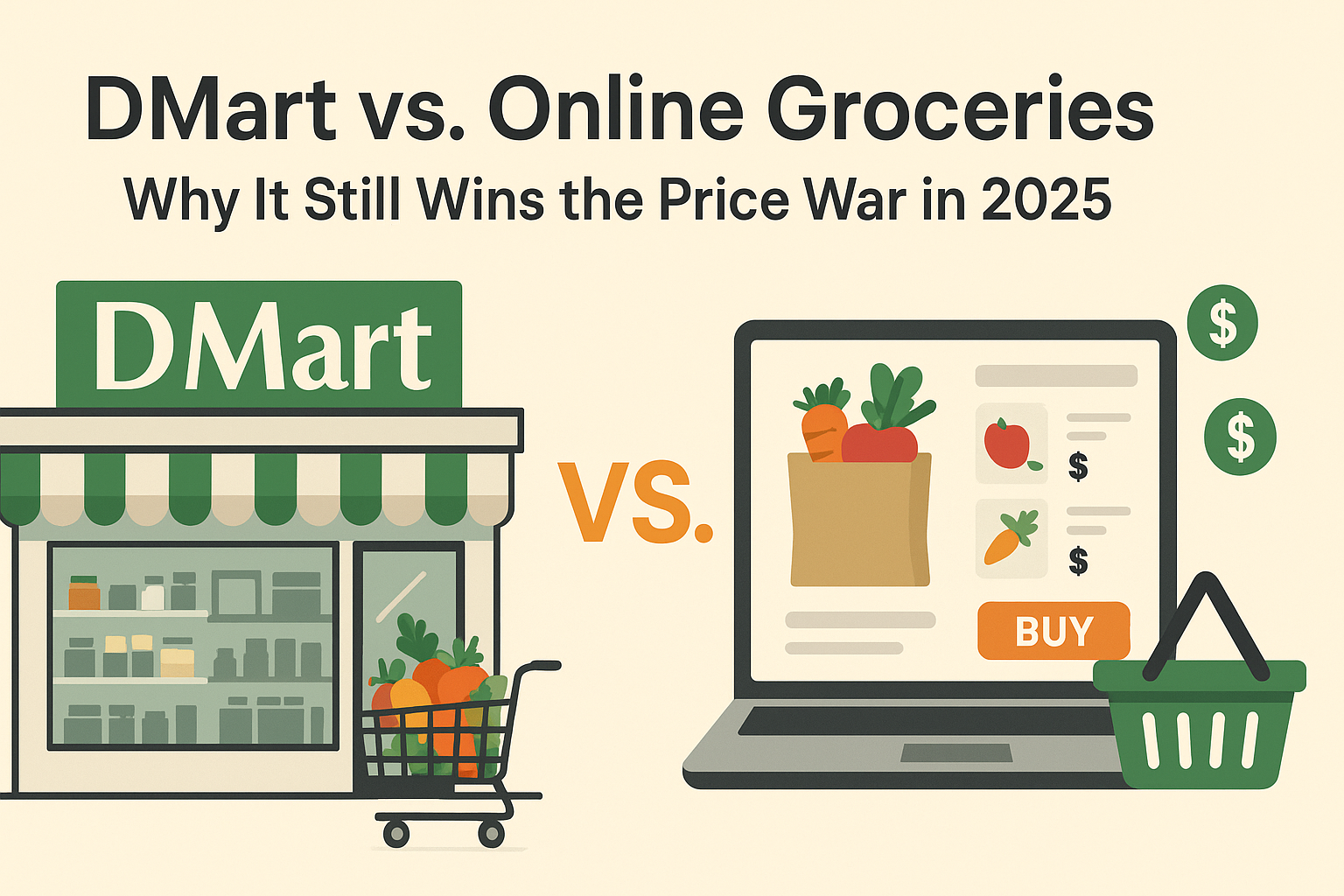In an era dominated by the instant gratification of Swiggy Instamart and Blinkit, and the vast marketplaces of BigBasket and Zepto, the enduring appeal of a trip to DMart might seem like a relic of the past. Why would anyone brave traffic and queues when groceries can be delivered to your doorstep in minutes?
The answer, in 2025, remains surprisingly simple: price.
While online q-commerce (quick commerce) has won on convenience, DMart continues to reign supreme in the battle for your wallet. This isn’t just about a few rupees; it’s about a fundamentally different business model that has proven resilient against the digital onslaught. Let’s break down why, for the budget-conscious shopper, DMart is still the undisputed champion of low prices.
The Core of the Conflict: Two Different Philosophies
The price war between DMart and online groceries is a clash of two distinct retail philosophies.
- DMart’s Model: Everyday Low Cost (EDLP). DMart’s foundation is hyper-efficiency in its supply chain, real estate, and operations. It passes these cost savings directly to the customer in the form of consistently low prices, every single day. No flash sales, just predictable value.
- Online Q-Commerce Model: Convenience at a Cost. Platforms like Instamart and Blinkit are built for speed. Their value proposition is time, not just price. The cost of maintaining dark stores, hyper-local delivery fleets, and a complex tech stack is inherently higher, and this is reflected in their product margins.
Head-to-Head Price Breakdown: Where DMart Saves You Real Money
Let’s look at a direct comparison of common grocery items. While online prices are dynamic, the following table illustrates a typical pricing trend.
| Product Category | DMart (Everyday Low Price) | Online Q-Commerce (Blinkit/Instamart) | Why DMart is Cheaper |
|---|---|---|---|
| Staples (e.g., 1kg Fortune Atta) | ₹ 50 | ₹ 55 – 60 | Bulk procurement, minimal packaging, and no last-mile delivery cost per item. |
| Private Label (e.g., 1L Sunflower Oil) | ₹ 190 (DMart Premia) | ₹ 220 (Third-party brand) | DMart’s own brands eliminate brand markup and distributor margins. |
| Personal Care (e.g., 1L Clinic Plus Shampoo) | ₹ 205 | ₹ 225 – 240 | Higher margins needed by online platforms to cover delivery and operational costs. |
| Dairy (e.g., 1L Amul Taaza Milk) | ₹ 58 | ₹ 62 – 66 | Despite being a branded item, DMart’s volume allows for better deals with suppliers. |
| Snacks (e.g., Lays Packet) | ₹ 20 | ₹ 30 | Online platforms often have a “convenience markup” on low-cost, high-impulse items. |
Interlink: To understand how DMart achieves these low prices, read our deep dive into The DMart Business Model: The Secret to Everyday Low Prices.
The 5 Unbeatable Advantages DMart Holds in 2025
1. The Private Label Powerhouse
This is DMart’s single biggest weapon. Brands like DMart Premia (staples), DMart Minimax (snacks), and DMart Happy Home (cleaning) offer quality comparable to national brands but at a 20-30% lower price. Online grocers have attempted private labels, but none have achieved the same scale, customer trust, and penetration as DMart.
2. The Bulk-Buying Bonus
DMart’s entire store layout and pricing are designed for the stock-up shopper. Buying a 5kg bag of rice, a large detergent bottle, or a dozen soap bars is significantly cheaper per unit at DMart. Online q-commerce, built for small, immediate orders, simply cannot compete on the economy of scale for bulk purchases.
Interlink: Ready to master the art of saving at DMart? Explore our 7 Expert Tips to Maximize Your DMart Discount Shopping.
3. Zero Hidden “Convenience Tax”
When you order online, you’re not just paying for the product. You’re paying for:
- Delivery Fee (unless you have a membership).
- Platform Convenience Fee.
- Higher Product Markups to cover the platform’s operational costs.
At DMart, the price on the tag is the price you pay at the checkout. There are no hidden costs.
4. The “See-and-Touch” Assurance (Especially for Fresh Produce)
For fruits, vegetables, and meat, the ability to physically select your items is a massive advantage. While online platforms have improved their quality checks, the risk of receiving bruised produce or a less-than-fresh cut of meat remains. At DMart, you have complete control over the quality of the fresh items you purchase, ensuring no money is wasted on subpar products.
5. Membership That Actually Saves (Without a Subscription)
Online platforms lock their best prices and free delivery behind monthly or annual subscriptions (Swiggy One, Blinkit Gold). DMart requires no membership fee. Its “Everyday Low Price” promise is available to everyone, from the first-time visitor to the regular customer, making it inherently more democratic and accessible.
Where Online Groceries Undeniably Win (And It’s Not Price)
To be fair, the online model has its own, powerful strengths that DMart cannot match. The winner depends on your priority.
| Factor | Winner | Why |
|---|---|---|
| Ultimate Convenience | Online Q-Commerce | Delivery in 10-20 minutes is unbeatable for emergencies. |
| Small, Top-Up Orders | Online Q-Commerce | Perfect for ordering 1-2 items without leaving home. |
| Everyday Lowest Prices & Bulk Buys | DMart | The fundamental cost structure favors the physical bulk model. |
| Fresh Produce Selection | DMart | Physical inspection trumps algorithm-based picking. |
| Payment & Card Offers | Tie | Both offer occasional bank discounts. |
Interlink: For those times when speed is essential, check out our review of the best quick-commerce apps: Fresh Groceries Delivered in Minutes: Swiggy Instamart Reviewed.
The Verdict: A Hybrid Strategy for the Smart Shopper in 2025
So, who truly wins the price war? The data and the business models point to a clear conclusion.
DMart wins the price war decisively for the primary, stock-up monthly grocery haul.
However, the smartest shoppers in 2025 don’t pledge allegiance to a single channel. They adopt a hybrid strategy:
- The DMart Run (Weekly/Bi-Weekly): For all your bulk staples, private-label goods, household essentials, and fresh produce you want to hand-pick. This is where you save the most money.
- The Online Top-Up (As Needed): For those moments when you run out of milk, need ingredients for an unplanned recipe, or simply can’t make it to the store. This is where you save time.
Final Tally: The Bottom Line
| Your Shopping Goal | Recommended Platform | Primary Benefit |
|---|---|---|
| Monthly Budget Shopping | DMart | Maximum Savings |
| Last-Minute/Emergency Needs | Instamart/Blinkit | Ultimate Convenience |
| Wide Brand Selection & Offers | BigBasket/JioMart | Variety & Digital Discounts |
Conclusion: The Brick-and-Mortar Behemoth Isn’t Going Anywhere
While the siren song of 10-minute delivery is powerful, the fundamental economics of grocery retailing still favor the efficient, bulk-oriented, private-label-driven model that DMart has perfected. It proves that in the quest for the lowest possible price, a well-executed physical retail strategy can not only compete with but consistently outperform its digital rivals.
For the average Indian household where the grocery bill is a significant monthly expense, the trip to DMart remains a non-negotiable ritual for saving money. In the price war of 2025, DMart is still your most powerful financial ally.
Are you planning to go grocery shopping and write on paper? why don’t you try Trupricer.com a digital shopping list creator Using trupricer mobile app, you can create a digital monthly shopping list in the app and there is no need to struggle with writing a list on paper every time
Andriod store link to download the app: https://play.google.com/store/apps/details?id=com.trupricer.user
IOS app store link :https://apps.apple.com/in/app/tru-pricer/id6480042106


